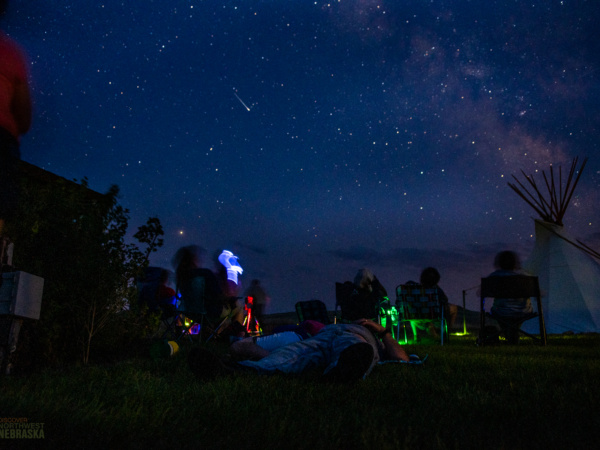PPDC instrumental in bringing Clash of the Mammoths exhibit home
By Kerri Rempp
Discover Northwest Nebraska Director
The fossil record of Northwest Nebraska is well-known among professionals and hobbyists alike, and one of the premier locations to learn more about that fossil record is at the Trailside Museum at Fort Robinson State Park.
Though Trailside Museum, operated by the University of Nebraska State Museum remained closed this year due to the COVID-19 pandemic, it’s using the time to prepare for the museum’s 60th anniversary, which will be celebrated in 2021.
Interest in the fossil record of Northwest Nebraska by the University Museum dates back to 1891, when Dr. E.H. Barbour led the organization’s first expedition to the region. According to Trailside’s website, that trip to the Fort Robinson area occurred shortly after the Battle of Wounded Knee and field explorations have visited western Nebraska for the University Museum nearly every year since.
“Nebraska as a state is an incredible database and wealth of fossils,” said Caroline Clements, the public relations and membership manager for the University Museum. Trailside is one of four facilities in the system that also includes Morrill Hall at UNL, Ash Fall Fossil Beds and the Research and Collections Department. In addition to Trailside’s 60th anniversary, the UNL Museum system as a whole will mark its 150th anniversary next year.
The University system began exploring ways to expand its facilities to western Nebraska several years before it opened the Trailside Museum in the old Army Theatre building, which it acquired from the U.S. Department of Agriculture in 1955. It opened as Trailside Museum July 3, 1961, highlighting exhibits that interpret the natural history and geological record of the region; today, Trailside draws an average of 10,000 visitors annually.

While the museum features exhibits ranging from invertebrate fossils and ammonites to examples of prehistoric marine and land reptiles, arguably the most popular exhibit is “Clash of the Mammoths.”
The fossils of two Columbian mammoths locked together in battle were discovered by Ben Ferguson and George McMillan in 1962 as the Soil Conservation employees were surveying an area for a dam on Dirty Creek. Ferguson and McMillan reported their discovery to staff at Trailside, allowing staff and students to begin the excavation project. Initially, researchers believed they were uncovering the remains of a single mammoth, but the find took on more importance when field crews realized there were two complete skeletons entwined at the tusks.
“Nothing in the fossil world had ever been found this way,” said Mark Harris, former associate director of the NU State Museum, in a 2012 interview with The Chadron Record.
“The Crawford mammoths are extremely unique,” said Shane Tucker, who works in the museum’s vertebrate paleontology department. “It’s actively preserving the behavior of the mammoths. Here we have a whole story about how these two animals ended up dying.”
The museum system has four tusks in its collection from two other mammoths that died intertwined but the rest of the skeletal remains had decayed, Tucker added. Researchers believe the Crawford mammoths died near the end of spring, during the musk, but don’t have an exact age of the fossils, he continued.
The mammoths were transported to the University of Nebraska-Lincoln after the excavation was complete, where they were housed in the museum system’s closed collections for the next 43 years.
Their return to Trailside Museum was facilitated by a group of local residents interested in exhibiting the Clash of the Mammoths in their Northwest Nebraska home. The Prehistoric Prairies Discovery Committee was formed as a partnership with the U.S. Forest Service as an effort to construct a new museum to house the mammoths, said Rosemary Petersen, a long-time volunteer with the group.
The U.S. Forest Service donated land adjacent to Fort Robinson State Park and commissioned blueprints for what they hoped would become the Prehistoric Prairies Discovery Center. The group conducted local fundraisers and lobbied the Nebraska Legislature for funding. Eventually, PPDC realized securing funding to construct a new museum was beyond its reach and the group shifted its goal to helping the University system renovate Trailside Museum as a suitable home for the mammoths.
They hosted a Mammoth Walk from Crawford to Fort Robinson State Park each year to raise funds and promote the idea of bringing the mammoths home.
“It was amazing. Kids went out and got pledges to earn prizes. We raised a lot of money with that Mammoth Walk and designed a new t-shirt every year with ‘Bring the Mammoths Back,’” Petersen said.
PPDC at one point secured grant funding to support an office and an employee in Crawford to work on the project of returning the Clash of the Mammoths to Northwest Nebraska. Work on the Trailside Museum included renovations to the former stage area of the building with the assistance of the Pine Ridge Job Corps and the installation of a sprinkler system to protect the valuable fossils, said Patricia Norman, who has worked at the museum since 2010.
Still, it wasn’t until 2005 that the Clash of the Mammoths exhibit was installed at the Trailside Museum.
“We were delighted (to learn they were returning),” Petersen said. “We earned it. It’s a one-of-a-kind find, and we’re proud to have it displayed. It was a project well worth working on.”
PPDC has continued to assist the museum since that time, and in recent years changed its mission statement to aid other Northwest Nebraska facilities dedicated to preserving and showcasing the region’s geologic record. A $5,000 effort to create new outdoor interpretive signage at Hudson Meng Bison Bonebed was another major project for the group. PPDC voted to dissolve earlier this year, however, donating its final $11,000 of funding to Trailside Museum.
“What they’ve done for the museum is just fabulous,” Norman said. “(They’ve helped) turn it into a real interesting place.”
For more information about Trailside Museum, visit https://trailside.unl.edu/.








